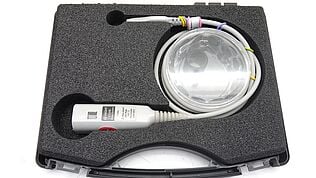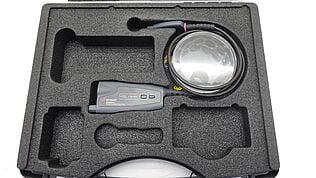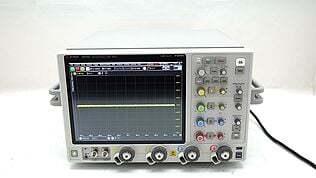- Introduction
- How Does an Oscilloscope Measure Frequency?
- What Is a Timebase?
- How To Calculate Frequency
- What Is FFT?
- What Is Cutoff Frequency?
- What Is a Square Wave, and How Does It Relate to Frequency?
- What Is Frequency Deviation?
- FAQ
- Buy a Keysight Premium Used Oscilloscope That Arrives at Your Lab in 2 Weeks
- Here Are 4 Ways We Can Help You
The primary function of any digital oscilloscope is to measure the signal voltage over time. However, an equally important measurement is the frequency of a signal. Oscilloscope frequency is how often a waveform or signal repeats itself over a given period.
Frequency measurements are in hertz (cycles per second) or kilohertz (thousands of cycles per second).
Using an oscilloscope to read frequency, you can measure at the same time:
- The time period of an input signal
- The amplitude of a waveform
- The duty cycle between two digital signals
Buy Oscilloscopes at a Great Discount
How Does an Oscilloscope Measure Frequency
Modern digital oscilloscopes automatically measure the frequency of an incoming signal.
It measures how many waveforms a signal contains over a certain amount of time. Then, to calculate the frequency it divides the number of waveforms by the amount of time.
Oscilloscopes also use a "frequency counter" feature, which measures the number of times a signal crosses a specific threshold over a given time scale.
A frequency counter counts how often an event occurs and calculates the number of events per second. It then displays the results in hertz.
These methods can provide accurate measurements over various frequencies.
What Is a Timebase?
A timebase is a feature of an oscilloscope that allows you to view the waveform over time. It sets the horizontal scale for the signal and enables you to measure the frequency or period accurately.
The time base can also visually slow down or speed up signals, making them easier to analyze on the display.
How To Calculate Frequency
If you own an older oscilloscope that cannot automatically measure frequency, don't worry – there are other ways to calculate the frequency.
- The most basic method is to measure the time for one complete waveform cycle and taking the inverse (1/t). This will give you an estimate of the frequency.
- You can also use your oscilloscope's "marker" feature to measure the time it takes for a signal to move from one point to another. You can then take the inverse (1/t) to get a frequency measurement.
- Another method is to take two measurements from different positions on a single rising or falling edge, then use the following formula: Frequency = (1 / Time difference) × 2π radians per cycle. The results will be your frequency in hertz.
What Is FFT?
Fast Fourier Transform (FFT) is a mathematical algorithm that extracts frequency information from a digital signal. Typical uses of FFTs are in analyzing sound and electrical signals, such as those produced by an oscilloscope.
The FFT algorithm breaks down a signal into its frequency components and then displays them in a spectrum graph. The graph allows you to visualize the signal's frequency content and identify any fluctuations or anomalies.

What Is Cutoff Frequency?
The cutoff frequency is when a signal begins to drop off or weaken. It determines the maximum frequency a digital oscilloscope can accurately read.
It is important to note that the cutoff frequency is not a hard limit – it is simply the point beyond which the oscilloscope's performance degrades.
For this reason, digital scopes are often designed with a significant margin of safety to ensure that they can still operate within their specified range. This is the case even if there are slight variations in their performance.
What Is a Square Wave, and How Does It Relate to Frequency?
A square wave is a signal that alternates between two levels, with equal amounts of time spent at each level. It has sharp transitions from one level to the next and is a periodic waveform.
Square waves are often used in digital circuitry because they produce distinct, easily identifiable signals that computers can easily interpret.
Square waves also test the frequency response of a system, as they contain several different frequencies in their signal components.
Frequency response measures how well a system responds to a given input frequency. You can then determine your system's performance under various operating conditions by testing it against different frequencies.

What Is Frequency Deviation?
In radio wave analysis, frequency deviation refers to the maximum deviation between the modulated and unmodulated carrier signal. However, in a broader sense, frequency deviation refers to the difference between the ideal or reference signal and the actual signal.
For example, if two waves have 100 Hz and 102 Hz frequencies, their frequency deviation would be 2 Hz.
Frequency deviation is related to the range of frequencies it contains. A signal with a large frequency deviation will have a large bandwidth and vice versa.
Frequency deviation is important to know when dealing with any signal, as it can affect the system's accuracy or quality. If a system is not calibrated correctly, it can lead to inaccurate readings or distorted audio or video.
FAQ
| What is mean frequency? | Mean frequency is the average frequency of a signal over a given period. You calculate mean frequency by dividing the total number of cycles that occur in one period by the length of the period. Mean frequency helps understand a signal's average shape over time and for comparing different signals. |
| What is mean frequency? | Mean frequency is the average frequency of a signal over a given period. You calculate mean frequency by dividing the total number of cycles that occur in one period by the length of the period. Mean frequency helps understand a signal's average shape over time and for comparing different signals. |
| What is AC frequency? | AC frequency, also known as alternating current frequency, is the rate at which an AC signal oscillates (varies in strength and direction at regular intervals). AC frequency is important for understanding how electricity flows through circuits and devices and troubleshooting electrical components. In the United States, the standard AC frequency is 60 Hz, which means that the current changes direction 60 times per second. The higher the frequency, the faster the current changes direction. It is common to find high-frequency AC in electrical equipment, such as TVs and computers. But for most uses, such as powering light bulbs and appliances, the AC frequency does not need to be very high. |
| What is maximally flat frequency response? | In audio engineering, the phrase "maximally flat frequency response" describes a system whose frequency response is as flat as possible over the entire range of frequencies it reproduces. This means the system produces the same frequency output level, a level that is as close to perfect as possible. In other words, a maximally flat response will have a minimal deviation, with no peaks or dips in the frequency curve. This is the ideal type of response for audio equipment, as it ensures that all frequencies are accurate. While it is not always possible to achieve a perfectly flat response, many manufacturers strive for this goal in their products. One way to achieve a maximally flat frequency response is to use a linear phase filter. This type of filter does not change the signal phase at any frequency, which helps minimize unwanted time-domain artifacts. As a result, you find linear phase filters in high-end audio systems where fidelity is paramount. |
Buy a Keysight Premium Used Oscilloscope That Arrives at Your Lab in 2 Weeks
Buying a used oscilloscope through Keysight is easy and convenient. Keysight's range of tested premium used oscilloscopes ensures the highest quality at a fraction of the cost.
This quality ensures you get an oscilloscope with frequency measurements that are accurate, reliable, and consistent every time.
While other resellers' shipping times vary from 8-21 weeks, a Keysight Premium Used oscilloscope will arrive at your Lab in just two weeks*.
This fast delivery time ensures you can get accuracy and reliability without waiting months at a time. So whether you are testing a new device or troubleshooting an existing design, trust Keysight for the highest quality used oscilloscopes.
So don't wait; see our used equipment page and pick up a premium refurbished oscilloscope with some of the highest standards and specifications in the industry.
(* Two weeks shipping time offer available for US customers only. Dependent on item availability and location.)
Browse Oscilloscopes at a Great Discount
Select up to 3 instruments to compare
Enable Notifications
In order to use this feature, you need to enable notifications.
Manage notification preferences
Did You Know?
Keysight is the only company that can provide calibration. When you buy from our used equipment page, you can rest easy knowing that your oscilloscope has been thoroughly tested and calibrated.
You can get straight to work using a reliable and accurate piece of equipment of the highest standard. No other reseller can provide that guarantee. That's why choosing Keysight for refurbished products is always the smartest choice.

Here Are 4 Ways We Can Help You
- Browse our premium used oscilloscopes
- Call tech support US: +1 800 829-4444
Press #, then 2. Hours: 7 am – 5 pm MT, Mon– Fri - Talk to our sales support team by clicking the icon (bottom right corner) on every offer page
- Talk to your account manager about your specific needs








































